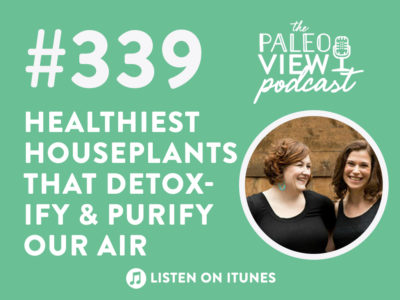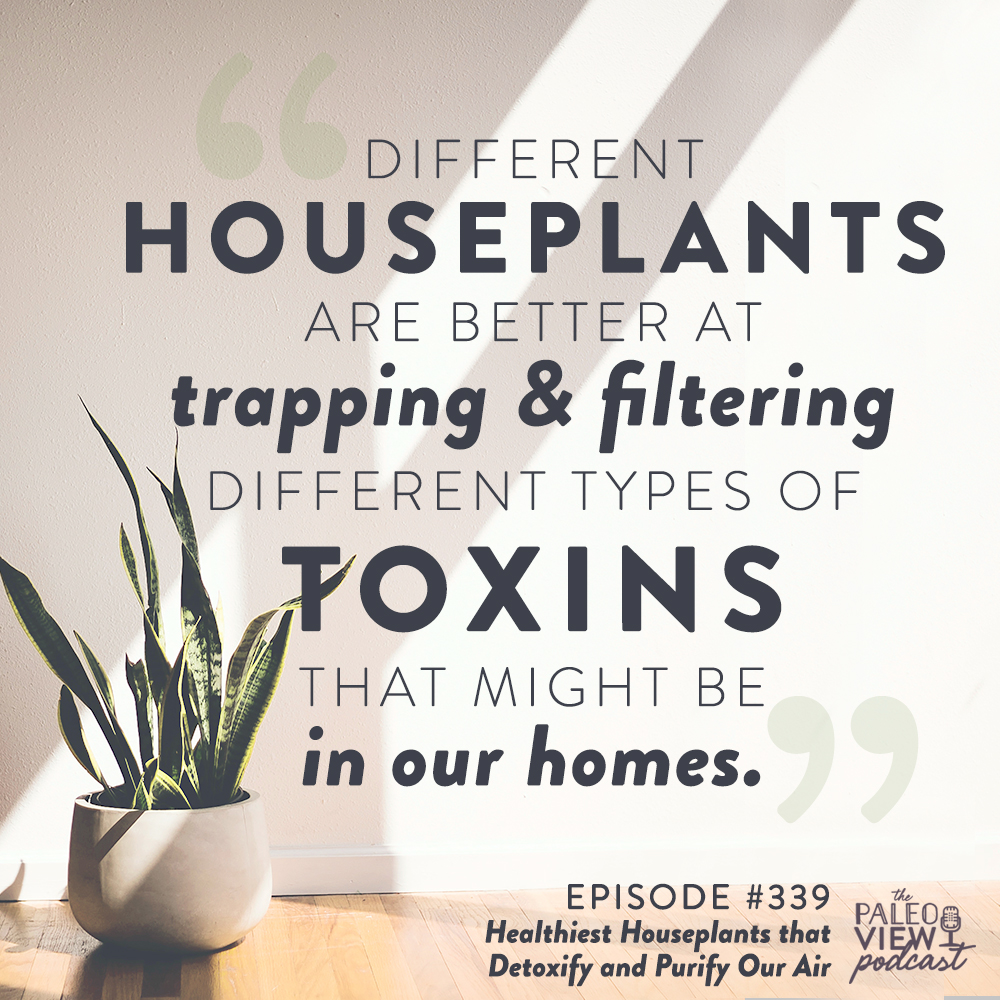In this episode, Stacy and Sarah share why you need houseplants, the health-harming toxins they protect against, the best houseplants for air purification and detoxification (especially if you have pets and a black thumb), and tips for keeping them alive.
Click here to listen in iTunes
or download and listen by clicking the PodBean Player below
![]()
If you enjoy the show, please review it in iTunes!
The Paleo View (TPV), Episode 339: Healthiest Houseplants that Detoxify and Purify Our Air
-
-
(0:00) Intro
- Stacy prepared a record number of notes for today’s podcast topic – 24 pages!
- Sarah is putting the finishing touches on the slides for her event this weekend, ThePaleoMom Workshop and Retreat at 1440 Multiversity!
- Today’s topic: houseplants!
- FYI, “houseplants” is one word! That’s something Stacy learned preparing for this show.
- Houseplants can act as air purification systems in your home. However, they can be toxic to pets.
-
(14:20) What’s in our air that plants could help purify?
- In 1989, NASA did a study to figure out how to purify the air for astronauts in space. They screened for the toxins, benzene, formaldehyde, and trichloroethylene.
- Since then there have been a number of other studies identifying other air toxins including xyelene and ammonia.
-
Benzene
- is a toxic, volatile, flammable liquid hydrocarbon which is a byproduct of coal.
- It’s an industrial solvent found in most things to do with furniture: paints, varnishes, lacquer thinners.
- Benzene causes central nervous system damage, bone marrow damage, and is carcinogenic.
- Stacy notes that there are companies out there who do not use these chemicals. One that Stacy found is Pottery Barn (not an endorsement).
-
Formaldehyde
- Environmentally, it can be found in the atmosphere, fire smoke, and cigarette smoke (to name a few).
- Really dangerous when ingested. Vapor can be toxic. Can be managed in small loads.
-
Trichloroethylene
- A synthetic, volatile, light-sensitive, colorless, liquid that is miscible with organic solvents.
- Associated with metal because it can be used as a degreaser.
- In the process of combustion, it can produce irritants and toxic gases, which can lead to liver cancer, kidney cancer, and lymphoma.
- Considered a human carcinogen.
- In 1989, NASA did a study to figure out how to purify the air for astronauts in space. They screened for the toxins, benzene, formaldehyde, and trichloroethylene.
-
(21:42) Why are plants good detoxifiers and which are best?
- Photosynthesis! They take in the air for photosynthesis to use carbon dioxide. They trap the toxic chemicals and filter them through their root process.
- It’s largely leafy plants (that don’t have a lot of flowers) with a strong root system that are the best purifiers.
- Stacy and her family started with a Money Tree because it was strong, sturdy, has a good root system, and is hard to kill (Stacy doesn’t exactly have a green thumb). Every couple of months they add a new plant.
- These leafy plants alleviate “sick building” syndrome.
- Sarah notes that in addition to purifying air, plants also have a calming effect. Check out their podcast episode TPV Podcast, Episode 267: The Benefits of Nature for more on that!
- Ivy plants make great office plants because they’re air purifiers, but they’re toxic to pets if eaten.
- Snake plants are also great air purifiers. They, too, are toxic to pets. Stacy has come up with a workaround to this by putting it on a pedestal in her home, out of reach from pets.
- What happens to the toxins plants take in? Plants, like us, have microbiomes. The soil also has a microbiome. Bacteria are amazing detoxifiers, so they metabolize the toxic compounds into harmless compounds.
- In the 1989 NASA study discovered that houseplants made a significant difference in removing VOCs from the air. They tested a number of different factors like leaves, flowers, roots, and that’s how they determined the plants with root systems are the best for purification.
- Sarah notes that in this study, some of these plants could remove up to 90% of benzene in the air in 24 hours. That’s incredibly efficient!
- English Ivy is one such plants that remove up to 90% but beware as it is toxic when ingested.
- This database on the ASPCA identifies plants that are toxic to pets.
-
(39:55) Purifying houseplants good for pets and a black thumb
- Stacy has created a list of houseplants that are hard to kill, good for pets, purify, are non-toxic, are more hearty, and do not require full sun.
- Areca Palm
- Shown to purify against formaldehyde, xylene and toluene
- Requires partial shade
- non-toxic
- Spider Plant
- Shown to purify against formaldehyde, xylene and toluene
- Requires partial to full shade
- non-toxic
- Flamingo Lily
- Shown to purify against formaldehyde, ammonia, xylene and toluene
- Requires full sun to partial shade
- Toxic to cats
- Peace Lily / Aspidistra
- Shown to purify against benzene, formaldehyde, trichloroethylene, ammonia, xylene and toluene
- Requires partial to dappled shade
- Toxic to cats
- Variegated Snake Plant
- Shown to purify against benzene, formaldehyde, trichloroethylene, xylene and toluene
- Requires partial to full shade
- Toxic to cats and dogs
- Aloe Vera
- Shown to purify against benzene and formaldehyde
- Requires full sun to partial shade
- Healing properties
- Toxic to cats and dogs
- Banana Tree
- Shown to purify against formaldehyde
- Requires full sun to partial shade
- Non-toxic
- Pachina Money Tree (Scindapsus aureus)
- Shown to purify against benzene, formaldehyde, trichloroethylene, xylene and toluene
- Requires partial to full shade
- Non-toxic
- Cactus
- No known purification benefits, but it has a good root system
- Requires partial to dappled shade
- Non-toxic
- Really hard to kill
- Plants make great gifts!
- Stacy chooses to include the Snake Plant, ZZ, and Aloe in her home, despite their toxicity for animals, because of their health benefits. All are out of reach of pets and do not “shed” leaves, making them less of a risk for her home – but be mindful about placement for these 3 plants if you have pets.
- Tips for keeping your plants alive
- Get plants that have the same watering needs
- Get plants that do well with having both wet and dry soil
- Use a plant watering bulb
- Set a reminder to water the plants
- Pay attention to sunlight needs and put them in the appropriate place
- Don’t buy plants that are half dead
- If your plant dies, you’re not a failure! The soil is still purifying the air!
-
- Get your questions in! We want to hear from you! And there’s no end to questions we can answer and topics we can address!
- Engage on social media! That’s how we get feedback!
- Thank you for listening.










